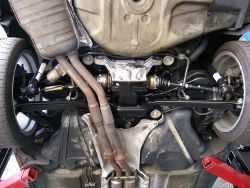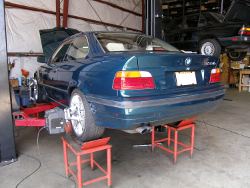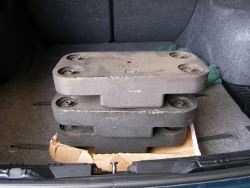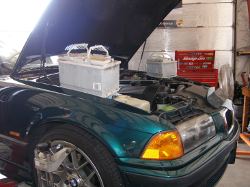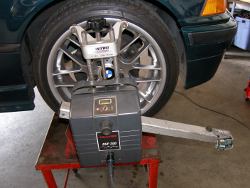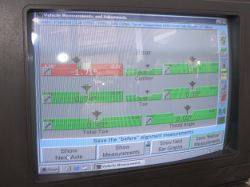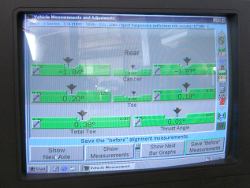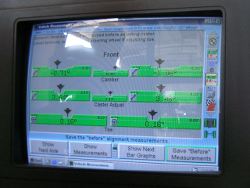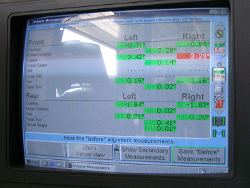Wednesday, July 7, 2010
Alignment
Last week I made an appointment at the dealer for an alignment simply because I got the last alignment done there, most generic alignment shops don't know how to align BMWs worth a damn, and frankly, I didn't know I had other options. I had resolved to pay the dealer's 2.5 hour ransom for an alignment until I learned that Don did alignments for a lot less using an older (but still quite useful) Hunter 611 alignment system. He said that most people don't think he does alignments because his shop lacks the traditional alignment rack equipped with turntables but as it turns out a full rack is a luxury and not a necessity. When Don agreed to do the job for a far more reasonable price it didn't take much effort on my part to call the dealer and cancel the appointment in favor of a new appointment at Don's shop for today.
I awoke to a weather forecast reminiscent of the past several weekends during which I worked on the vehicle drenched in sweat. Around Noon I arrived at Don's shop with the temperature solidly in 90's and knew this wasn't going to be fun for anyone involved. They had fans running in the shop, but as Don pointed out, in 95+ degree heat they feel like hair dryers. After waiting a few minutes for Don to stop cursing at the electrical system on a restored early 70's Jaguar he was working on, he pulled the E36 in and got to work.
If you've ever watched what happens to a suspension under load, you probably know instinctively that the specifications BMW supplies for camber, caster, and toe must be taken at a certain reference point. That reference point is the height of the fender well above the ground, which implies a specific degree of compression in the suspension. That, in turn, is set by loading the vehicle with lead weight, sandbags, dead hookers, old batteries, or whatever else might be lying around.
After Don loaded the vehicle appropriately, he raised it to chest height to install and calibrate each wheel sensor. Then he raised the vehicle as required to loosen the RTAB consoles and tie rod adjustment stop-nuts, at which point I took the opportunity to take a picture of the completed rear suspension overhaul I could not achieve with the vehicle on jack stands due to the limited sight distance.
My picture taking session was soon interrupted by Don muttering obscenities. The stop-nuts were frozen on both sides and no amount of penetrating fluid seemed to make a difference. So Don asked his tech to bring over the big guns -- an oxyacetylene torch. If you work on cars long enough you learn the law of maintenance: what cannot be fixed with a hammer can often be addressed with a bigger hammer, and failing that, heat. While Don grabbed the adjustment flats on the tie rod, his tech applied the flame to the area around the stop nuts. This caused the penetrating fluid to turn to flame, smoke and steam, and that ultimately dissolved the rust and freed the nuts. The car was then lowered onto some stands equipped with turntables to begin the adjustment process.
At this point, I got to take a look at the "before" alignment of the rear. Surprisingly, what I thought was a safe "toe in" estimate turned out to be about -0.3 degrees of toe (toe OUT) on each side. While the rear felt "locked down" in a way I hadn't experienced in years, this explains why it felt "eager" to turn in an unsettling way. As with all alignment specifications, there is an acceptable range of values, and BMW's minimum toe value is +0.05 degrees. Translated: no toe out. Of course, we're only talking fractions of a degree, but the point to take home here is that it doesn't take much to change the character of the vehicle.
The spec for rear camber on the sport package suspension is -2.3 degrees. Higher amounts of negative camber will help keep the rear locked down (lessen oversteer) at the expense of increased tire wear on the inside edge. I think BMW takes that to an extreme so we dialed a bit of camber out and left it at around -1.85 degrees. Toe is nothing to play with, however, so after using a screwdriver to nudge the RTAB consoles into spec he snugged those down and moved on to the front.
The perk about the rear end of the E36 is that it's adjustable to a small extent in both camber and toe. The stock front end, however, is only adjustable in toe. Caster and camber are fixed and based on the structure of the shock towers and the other suspension components. If one's intent is to maintain stock suspension geometry that doesn't sound like a big deal until you realize that the strut towers bend over time and don't always take kindly to the pounding of potholes. As it turns out, my right side caster is just out of specification and, perhaps more importantly, differs from the left by about 0.12 degrees. Camber is within spec on both sides, but different side to side as well.
How much these discrepancies affect the real-world handling of the vehicle is up for grabs, but the only way to fix them is to use caster/camber plates to make both caster and camber adjustable. The anal retentive German in me suggests that this might be something to address in the upcoming front end overhaul.
Mileage: 193850, Labor: $150




